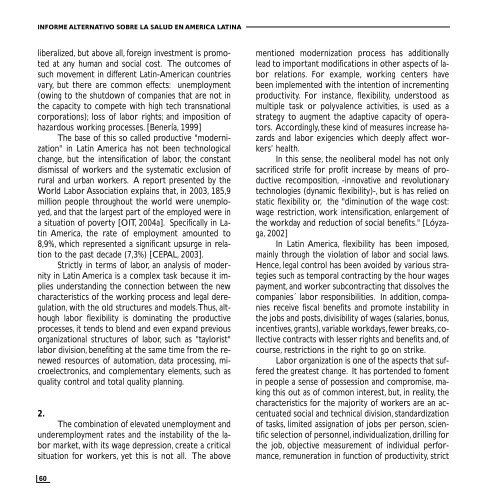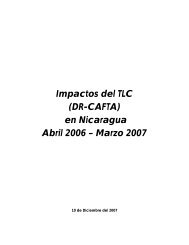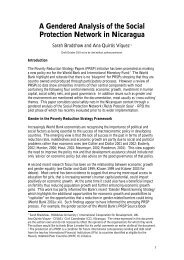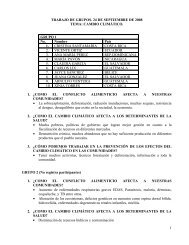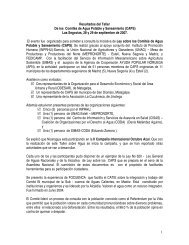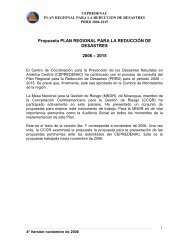Download - CISAS | Centro de Información y Servicios de AsesorÃa ...
Download - CISAS | Centro de Información y Servicios de AsesorÃa ...
Download - CISAS | Centro de Información y Servicios de AsesorÃa ...
You also want an ePaper? Increase the reach of your titles
YUMPU automatically turns print PDFs into web optimized ePapers that Google loves.
INFORME ALTERNATIVO SOBRE LA SALUD EN AMERICA LATINAliberalized, but above all, foreign investment is promotedat any human and social cost. The outcomes ofsuch movement in different Latin-American countriesvary, but there are common effects: unemployment(owing to the shutdown of companies that are not inthe capacity to compete with high tech transnationalcorporations); loss of labor rights; and imposition ofhazardous working processes. [Benería, 1999]The base of this so called productive "mo<strong>de</strong>rnization"in Latin America has not been technologicalchange, but the intensification of labor, the constantdismissal of workers and the systematic exclusion ofrural and urban workers. A report presented by theWorld Labor Association explains that, in 2003, 185,9million people throughout the world were unemployed,and that the largest part of the employed were ina situation of poverty [OIT, 2004a]. Specifically in LatinAmerica, the rate of employment amounted to8,9%, which represented a significant upsurge in relationto the past <strong>de</strong>ca<strong>de</strong> (7,3%) [CEPAL, 2003].Strictly in terms of labor, an analysis of mo<strong>de</strong>rnityin Latin America is a complex task because it impliesun<strong>de</strong>rstanding the connection between the newcharacteristics of the working process and legal <strong>de</strong>regulation,with the old structures and mo<strong>de</strong>ls.Thus, althoughlabor flexibility is dominating the productiveprocesses, it tends to blend and even expand previousorganizational structures of labor, such as "taylorist"labor division, benefiting at the same time from the renewedresources of automation, data processing, microelectronics,and complementary elements, such asquality control and total quality planning.2.The combination of elevated unemployment andun<strong>de</strong>remployment rates and the instability of the labormarket, with its wage <strong>de</strong>pression, create a criticalsituation for workers, yet this is not all. The abovementioned mo<strong>de</strong>rnization process has additionallylead to important modifications in other aspects of laborrelations. For example, working centers havebeen implemented with the intention of incrementingproductivity. For instance, flexibility, un<strong>de</strong>rstood asmultiple task or polyvalence activities, is used as astrategy to augment the adaptive capacity of operators.Accordingly, these kind of measures increase hazardsand labor exigencies which <strong>de</strong>eply affect workers’health.In this sense, the neoliberal mo<strong>de</strong>l has not onlysacrificed strife for profit increase by means of productiverecomposition, -innovative and revolutionarytechnologies (dynamic flexibility)-, but is has relied onstatic flexibility or, the "diminution of the wage cost:wage restriction, work intensification, enlargement ofthe workday and reduction of social benefits." [Lóyzaga,2002]In Latin America, flexibility has been imposed,mainly through the violation of labor and social laws.Hence, legal control has been avoi<strong>de</strong>d by various strategiessuch as temporal contracting by the hour wagespayment, and worker subcontracting that dissolves thecompanies´ labor responsibilities. In addition, companiesreceive fiscal benefits and promote instability inthe jobs and posts, divisibility of wages (salaries, bonus,incentives, grants), variable workdays, fewer breaks, collectivecontracts with lesser rights and benefits and, ofcourse, restrictions in the right to go on strike.Labor organization is one of the aspects that sufferedthe greatest change. It has porten<strong>de</strong>d to fomentin people a sense of possession and compromise, makingthis out as of common interest, but, in reality, thecharacteristics for the majority of workers are an accentuatedsocial and technical division, standardizationof tasks, limited assignation of jobs per person, scientificselection of personnel, individualization, drilling forthe job, objective measurement of individual performance,remuneration in function of productivity, strict60


